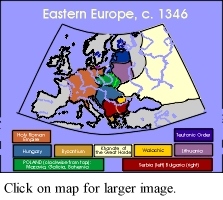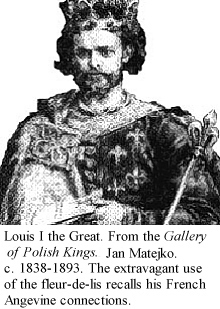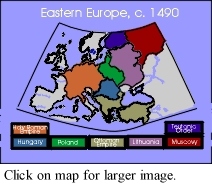The End of Europe's Middle Ages
Located on the periphery of Europe, Eastern Europe is comprised of Poland, Hungary and the many petty kingdoms of south-eastern Europe. Somewhat isolated from the rest of the continent, developments during the late Middle Ages occurred more slowly in Eastern Europe when compared Western European countries. Prior to the fourteenth and fifteenth centuries, Eastern European monarchs had lost much of their prestige and power and they functioned more as figureheads than as heads of state. During the later Middle Ages, however, these monarchs worked to re-establish their former authority. While Poland and Hungary became two of the largest kingdoms in Eastern Europe, the ability to dominate other kingdoms depended upon the strength of the reigning monarch and most of the Eastern European kingdoms remained without a strong centralised government throughout the Middle Ages.
Numerous and politically unstable, the petty kingdoms of south-eastern Europe are also known as the Balkans and they served as Europe's buffer zone against the expanding Ottoman Empire during the late Middle Ages. Although the noble classes were extremely powerful, they were guided more by self interest than by concerns for the welfare of their kingdoms and they failed to provide effective leadership. Because the Balkan kingdoms were unable to acquire and maintain unity, they could not mount effective defences and they were frequently invaded by both the Hungarian and the Ottoman armies. Although a few great leaders did arise to unite their Balkan kingdoms, their gains were quickly lost after they died.
In Hungary, the dynastic rule of the Arpads came to an end in 1301 following a three hundred year period. The Crown had lost most of its power and the king had become ineffective, a greater object of pity than of allegiance. Following a nine year battle for supremacy, a new dynasty, the Angevines, acquired the throne in 1310 under Charles Robert of Anjou. The Angevines re-established the power and prestige of the Hungarian Crown and the first two Angevine kings, Charles I (1288-1342), and his son Louis I the Great (1326-1382) were ideally suited to rule during this period in Hungary's history. Charles I was an adept politician who effectively eliminated opposition to the monarchy through negotiations with the nobility and was even called upon to mediate disputes in other European kingdoms. He acquired territories in Bosnia and Serbia and his marriage to the Polish king's sister, Elizabeth, provided his son Louis with a claim to the Polish crown.
When Louis I (1326-1382) succeeded to the throne in 1342, he did not continue his father's diplomatic policy. He was, rather, a warrior king who pursued an aggressive foreign policy, focusing the energies of the noble class outwards and distracting them from the growing power of the Crown. He spent several years in frustrating attempts to hold the kingdom of Naples and he fought three separate wars with Venice, finally acquiring control of the eastern Adriatic coast in 1381. He succeeded to the Polish crown in 1370 and Bulgaria, Moldavia, Serbia, and Walachia all fell within the Hungarian hegemony. By the time of Louis I's death in 1382, the Crown had direct control of about 15 per cent of the towns and castles, a percentage equal to that of the Church, and the balance was divided amongst the nobles and the gentry.
Despite the impressive gains made during his reign, Louis I died without a male heir and his kingdom was divided between his two infant daughters, Maria (1371-1395) and Jadwiga (1374-1399). Maria was designated the Polish heiress while Hungary was to fall to Jadwiga. However, Louis I's widow, Elizabeth of Bosnia (c.1340-1387), had other ideas and seized control of both kingdoms during the minority of her children. She had Maria crowned Queen of Hungary within a week of Louis I's death, hoping to have Maria succeed to the thrones of both Hungary and Poland. The plan failed and, in 1384, Jadwiga was crowned Queen of Poland and she was married to Jagiello of Lithuania in 1386.
The Hungarian nobility quickly came to resent the rule of Elizabeth and Maria and the crown was offered to Charles III of Naples in 1385. Elizabeth had him executed two months later, paying for her heinous crime when she herself was captured by rebellious nobles and tortured to death only a few months afterwards. Maria's fiance, Sigismund of Pomerania, was elected king of Hungary in 1387 and he married Maria later the same year. Although Sigismund (1368-1437) was a competent monarch, he was overwhelmed by a number of internal and external pressures during his reign. His crusade against the Ottoman Turks in 1396 ended in disaster at the Battle of Nicopolis. When he was named Holy Roman emperor in 1411 and acquired the kingdom of Bohemia in 1419, he was forced to deal with the numerous insurrections of the Hussites. He called the Council of Constance in 1414 and managed to resolve the Great Schism but his failure to protect the safety of Jan Hus, who was burned at the stake as a heretic in 1415, renewed Hussite insurrections.
After Sigismund's death in 1437, the Hungarian crown briefly fell to Sigismund's son-in-law, Albert II. A bitter struggle for the throne erupted when Albert II died in 1439. Ironically, the advances of the Ottoman Turks into the Balkans served to save Hungary from being torn apart by internal dissension. The Hungarian military hero János Hunyadi (c.1387-1456) led several successful and courageous campaigns against the Ottomans and his family rose to dominate the Hungarian political scene. Hunyadi helped to have the Polish king Wladyslaw III (1424-1444) elected king of Hungary and when Wladyslaw III was killed by the Ottomans at Varna, Hunyadi was named regent for Ladislav V (1438-1458), then only six years old. The disastrous defeat of the Hungarian forces at Varna also prompted Pope Calixtus III to call for a European crusade against the Turks in Eastern Europe. Unfortunately, few kingdoms actually responded to the call and Hunyadi was forced to lead a motley peasant army against a much larger, seasoned Ottoman force at the siege of Belgrade (Nandorfejervar) in June and July of 1456. Despite the enormous odds against them, the Hungarian forces were successful, the siege was lifted and the Ottoman army was forced to withdraw. Hunyadi contracted a disease, possibly cholera, that had spread from the Turkish troops to the European contingent at Belgrade and died in August 1456.
 |
János Hunyadi, Champion of Hungary - Saviour of Europe |
Despite a claim from the Holy Roman emperor Frederick III, Hunyadi's son Matthias Corvinus the Just (1443-1490) secured the throne when the young Ladislav V died without an heir in 1458. Matthias was a strong king who took steps to centralise government, circumventing the powerful nobility by building alliances with the gentry and creating a mercenary army, the Black Troops, to subdue opposition. A patron of art and learning, he introduced administrative and legal reforms and created new offices which he filled with his own supporters. Through his successful campaign against Frederick III, Matthias acquired Austria, Styria, and Carinthia and he moved his capital to Vienna in the late 1480s. Matthias' achievements demonstrate that, although Eastern Europe was on the periphery, it was not completely isolated from the events taking place in Western Europe and his reign calls to mind many of the developments of the New Monarchies. Unfortunately, after Matthias' death in 1490, the feudal nobility reasserted their authority and Hungary succumbed to a period of internal strife.
While Hungary's energies were necessarily directed towards the Balkans, Poland's attention was drawn towards Prussia. In 1225, the Teutonic Order of Knights was invited into Poland by the Duke Conrad of Masovia (1187-1247) to assist in the conversion of the pagan Prussians on the borders of Poland. The Teutonic Knights were very successful with their 'conversion by the sword' and, by 1329, the Order had acquired a papal fief along the Baltic coast. This cut off Poland's access to the Baltic Sea and, as a result, much of Poland's military energy during the late Middle Ages was directed against the Order in an effort to reclaim trade routes.
 |
Teutonic Knights |
Early in the fourteenth century, Poland's numerous principalities were united under Wladyslaw I Lokietek (1260-1333), who managed to press the Teutonic Knights back from Polish lands. Wladyslaw I's son, Kasimir III (1310-1370) continued to build on the progress made by his father. A skilled politician, Kasimir III reformed the legal system and codified the law, as wells as promoting royal officials instead of local administrators. He founded the University of Kraków in 1364 and assisted Jewish refuges fleeing from persecution in Western Europe. Kasimir III's reign focused on solidifying Poland's unity but at his death in 1370, the throne of Poland passed to Louis I the Great of Hungary. Louis governed through a representative who proved to be unpopular in Poland and the Polish-Hungarian union dissolved so at Louis I's death in 1382.
After Louis I's death there were questions about who should succeed. Eventually the issue was settled and Louis I's daughter
Jadwiga (1374-1399), ascended to the Polish throne. As a descendant of the Polish monarchy she was crowned queen of Poland in 1384, which put her on equal footing with her future husband,
Jagiello, the grand-duke of Lithuania, the last pagan country in Europe. Aware that conversion to Christianity was inevitable for
Lithuania and that it was his decision whether this conversion took place at the point of Teutonic swords or by a more peaceful method, Jagiello chose a union with Poland. He married Jadwiga in 1386 and ascended the throne as Wladislaw II Jagiello, uniting Poland and Lithuania against the Teutonic Knights and establishing the Jagiellon dynasty. The union was not without difficulties, however, and it was decided that Jadwiga would rule Poland while
Wladyslaw II Jagiello would direct his energies to converting Lithuania and introducing Polish institutions such as hereditary rights. After Jadwiga's death in 1399, Wladyslaw II Jagiello appointed his cousin, Witold, as the Lithuanian administrator.
After 1400, the remainder of Wladyslaw II Jagiello's reign was taken up with issues close to home, including defending against the Tatars and struggles with western Russia and the Teutonic Order in Prussia. Although Poland was Christian, the Teutonic Order had labelled the kingdom as pagan as a result of its union with non-Christian Lithuania and the Teutonic Knights circulated misinformation regarding Polish and Lithuanian "paganism" throughout Europe. In 1410, Wladyslaw II Jagiello defeated the Teutonic Order at the Battle of Tannenberg. With Poland's victory over the Teutonic Order, Europe realised that Poland had been misrepresented. As a result, the Teutonic Order lost much of its prestige and power and, when Wladyslaw II Jagiello presented Poland and Lithuania as Christian kingdoms at the Council of Constance in 1414, the two kingdoms were recognised and accepted on an equal basis with other Western European kingdoms.
Polish and Lithuanian concerns for equal representation within their union emerged after Wladyslaw II Jagiello's death in 1434, but when Kasimir IV (1477-1492) ascended to the throne in 1446, an uneasy peace was again established. A conflict between Poland and the Teutonic Order flared up in 1454, providing the Polish monarchy with the opportunity to fulfil a vow made a century and a half earlier: to win back its territory on the Baltic Sea from the Teutonic Knights. Kasimir IV required the participation of the gentry to mount his campaign and he granted several concessions that were confirmed in separate charters for each province, marking a significant step towards Polish constitutional development.
In the early 1480's, the
Tatars, invaders who had begun to expand out of Mongolia in the thirteenth century, began to pressure the south-eastern boundaries of Poland and Lithuania. This aggression facilitated a short-term co-operation between the two states, echoing the alliance of a century before when another common enemy, the Teutonic knights, made unification mutually beneficial. The Tatars were eventually defeated in 1491 by the united armies of Poland and Lithuania. Despite the success of this union, no single ruler was able to limit the power of the nobility and the peasantry relapsed into the quasi-slave status of serfdom.

 |
Return to Italy's City-States | Proceed to Ottoman Turks |  |
The End of Europe's Middle Ages / Applied History Research Group / The University of Calgary
Copyright © 1998, The Applied History Research Group


